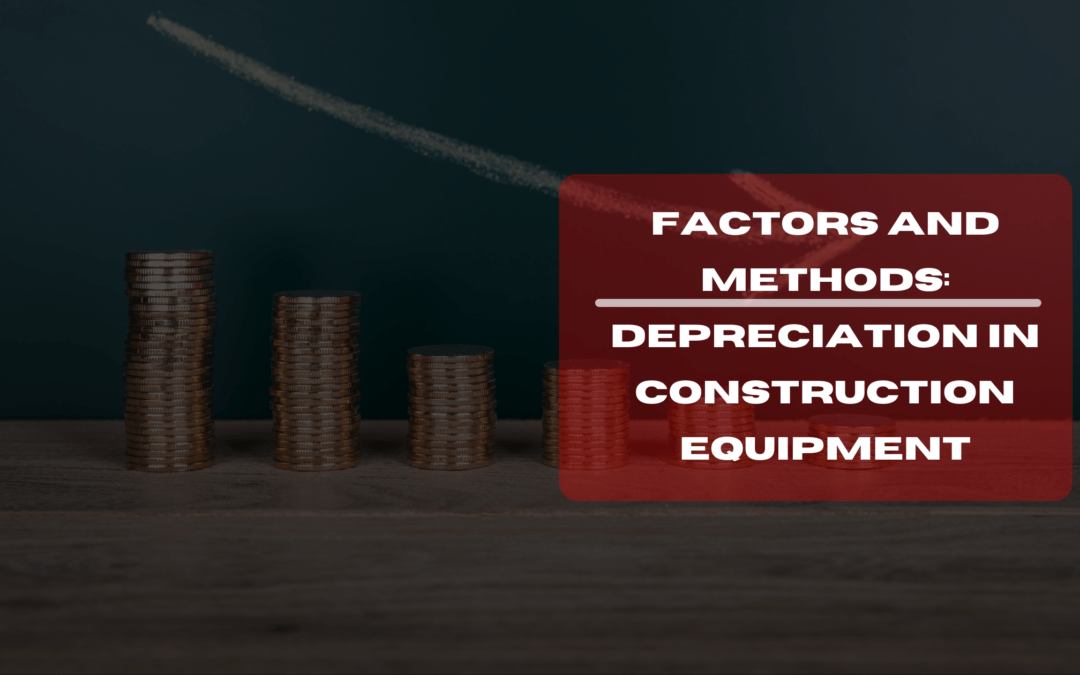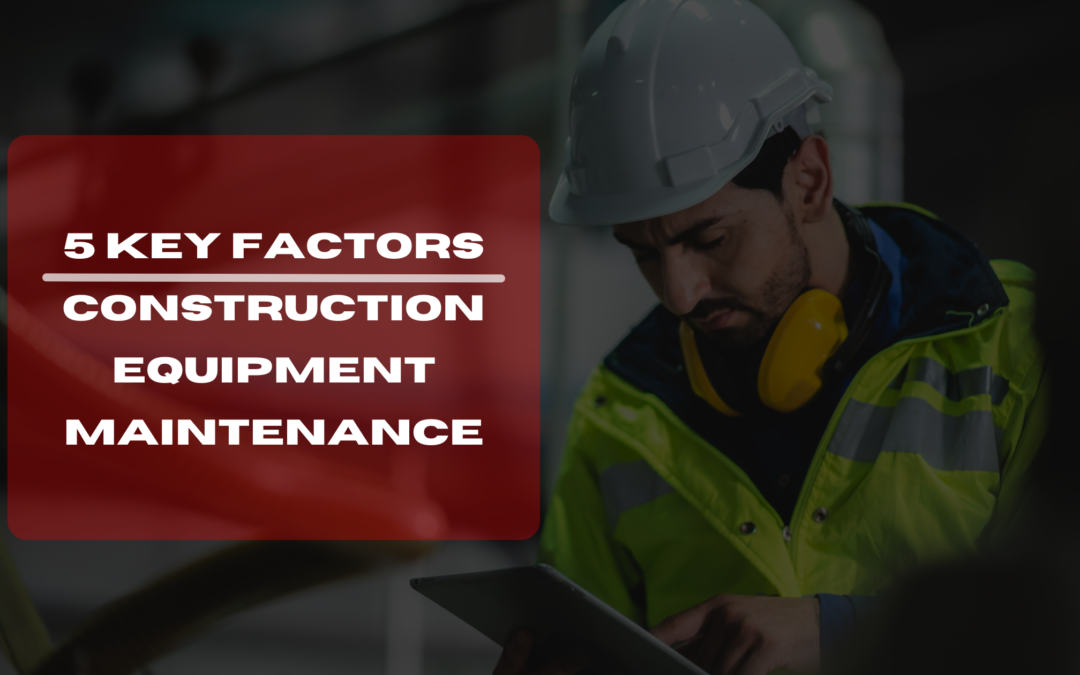
Resource Management, Finance Management, Project Management
Factors and Methods of Depreciation in Construction Equipment
In the world of construction, equipment is the unsung hero, powering the creation of infrastructure, buildings, and landmarks. However, as these mighty machines perform their duties day in and day out, they undergo a natural process known as depreciation. Depreciation is a crucial concept in construction equipment management and financial accounting, affecting a company’s balance sheet and decision-making processes. In this article, we will delve into the intricacies of depreciation, exploring what it is, why it happens, and the different methods used to calculate it.
Defining Depreciation
Depreciation refers to the gradual decrease in the value of an asset over its useful life. In the context of construction equipment, it represents the diminishing worth of machinery as it experiences wear and tear, obsolescence, and the passage of time. Depreciation is an accounting method used to accurately reflect an asset’s declining value on a company’s financial statements.
The Factors Behind Equipment Depreciation
Several factors contribute to the depreciation of construction equipment. Understanding these factors is essential for effective equipment management:
1. Physical Wear and Tear
Why it matters: Construction equipment operates in demanding environments, often exposed to heavy loads, vibrations, and harsh weather conditions. The physical wear and tear resulting from these conditions lead to a gradual deterioration of equipment components, affecting its performance and value.
Takeaway: Regular maintenance and inspections are crucial to mitigate the effects of wear and tear and extend equipment lifespan.
2. Technological Obsolescence
Why it matters: The construction industry continually evolves with advancements in technology. Newer equipment models often come with improved efficiency, safety features, and environmental compliance. As technology progresses, older equipment may become outdated and less competitive.
Takeaway: Staying updated with technological advancements and periodically assessing equipment for obsolescence can help in managing depreciation.
3. Market Demand and Supply
Why it matters: The resale value of used construction equipment is influenced by market dynamics. Oversupply of specific equipment types or reduced demand can lead to lower prices in the resale market, contributing to depreciation.
Takeaway: Keeping an eye on market trends and demand for specific equipment can aid in decision-making regarding equipment acquisition and disposal.
4. Maintenance Costs
Why it matters: Neglecting maintenance or failing to address issues promptly can result in higher repair costs. Inadequate maintenance practices can lead to more extensive damage, accelerating depreciation.
Takeaway: Implementing a proactive maintenance schedule can help control costs and minimize the impact of depreciation.
5. Usage Intensity
Why it matters: Equipment subjected to heavy and continuous use is more likely to experience faster depreciation. High usage leads to increased wear on critical components, shortening their lifespan.
Takeaway: Monitoring equipment usage patterns and ensuring that equipment is allocated efficiently can help extend its lifespan.
6. Equipment Age
Why it matters: Older equipment tends to depreciate faster than newer models. The wear and tear accumulated over the years, combined with the lack of modern features, contribute to reduced value.
Takeaway: Assessing equipment age and planning for timely replacements or upgrades is essential for managing depreciation.
Different Methods for Calculating Depreciation
Several methods are used to calculate depreciation, each with its own advantages and implications. Here are some common depreciation calculation methods:
1. Straight-Line Depreciation
How it works: This method spreads the depreciation expense evenly over the asset’s useful life. It is simple to calculate and provides a steady and predictable expense pattern.
Use case: Straight-line depreciation is suitable for assets with a relatively uniform rate of wear and tear.
2. Declining Balance Depreciation
How it works: Declining balance depreciation applies a higher depreciation expense in the early years of an asset’s life. It reflects the higher maintenance and repair costs typically associated with older equipment.
Use case: This method is suitable when equipment tends to require more maintenance as it ages.
3. Units of Production Depreciation
How it works: Depreciation is calculated based on the actual usage or production output of the equipment. The more the equipment is used, the higher the depreciation expense.
Use case: Units of production depreciation is ideal for equipment where usage varies significantly.
4. Sum-of-the-Years-Digits Depreciation
How it works: This method accelerates depreciation by assigning higher expenses in the earlier years of an asset’s life. It provides a middle ground between straight-line and declining balance depreciation.
Use case: Sum-of-the-years-digits depreciation suits assets that experience moderate wear and tear.
5. Double Declining Balance Depreciation
How it works: A variation of declining balance depreciation, this method doubles the rate of depreciation in comparison to the declining balance method.
Use case: It is used for assets that experience rapid wear and tear, especially in their early years.
6. MACRS (Modified Accelerated Cost Recovery System)
How it works: MACRS is a tax-related depreciation method used in the United States. It assigns specific depreciation rates based on asset types and their useful lives.
Use case: MACRS is primarily used for tax purposes and is specific to U.S. tax regulations.
In Conclusion
Depreciation is an inherent aspect of owning and managing construction equipment. It accounts for the natural wear and tear, technological advancements, and market fluctuations that equipment undergoes over time. By understanding the factors contributing to depreciation and selecting appropriate depreciation calculation methods, construction professionals can make informed decisions about equipment acquisition, maintenance, and replacement.
Effective depreciation management not only ensures accurate financial reporting but also contributes to efficient equipment utilization and cost control in the construction industry. In this ever-evolving field, staying informed and proactive is the key to maximizing the value and longevity of construction equipment.
“The best way to predict your future is to create it.” – Abraham Lincoln
Investing in proper equipment management and depreciation strategies is how construction professionals shape a successful future in this dynamic industry.

Project Management, Resource Management
Key factors to consider for Construction Equipment Maintenance
In the world of construction, equipment is the lifeblood of projects. From towering skyscrapers to intricate roadwork, the reliable operation of construction equipment is essential. Yet, every piece of machinery, no matter how robust, requires care and attention to keep it running smoothly. This brings us to the vital topic of evaluating the maintenance needs of construction equipment.
Unveiling the Essentials
Understanding the factors that influence maintenance decisions in construction is akin to mastering the art of preserving your project’s lifeline. Here, we unveil the key factors that should never be overlooked:
Factor 1: Usage Patterns
- Why it matters: The frequency and intensity of equipment use play a pivotal role in determining maintenance needs. Equipment subjected to continuous operation or heavy-duty tasks may require more frequent maintenance checks.
- Takeaway: Regularly assess usage patterns to tailor maintenance schedules accordingly, optimizing equipment performance and longevity.
Factor 2: Environmental Conditions
- Why it matters: Where equipment operates matters as much as how often it’s used. Harsh environments, such as extreme temperatures or exposure to corrosive substances, can accelerate wear and tear.
- Takeaway: Prioritize maintenance routines that consider the specific environmental challenges equipment faces, ensuring its resilience.
Factor 3: Manufacturer Recommendations
- Why it matters: Equipment manufacturers provide detailed guidelines for maintenance schedules and procedures. Ignoring these recommendations can not only void warranties but also compromise equipment performance.
- Takeaway: Always adhere to manufacturer recommendations to ensure proper care and operation of your equipment.
Factor 4: Age and Equipment History
- Why it matters: Older equipment may have different maintenance needs compared to newer counterparts. Reviewing equipment history can reveal recurring issues and areas of concern.
- Takeaway: Tailor maintenance plans based on equipment age and historical performance, addressing potential problem areas proactively.
Factor 5: Workload Variation
- Why it matters: Equipment subjected to varying workloads may experience different wear patterns. Understanding workload fluctuations helps in planning maintenance effectively.
- Takeaway: Consider workload variations when scheduling maintenance to align with the equipment’s actual usage.
“Preventive maintenance is the key to reliability.” – Christie Comstock
This quote by Christie Comstock underscores the importance of proactive maintenance in construction equipment. Preventive maintenance, guided by a deep understanding of the factors mentioned above, is indeed the key to ensuring reliability on the job site.
Maximizing Equipment Lifespan
Proactive maintenance isn’t just about fixing issues; it’s about preventing them in the first place. By addressing maintenance needs promptly, you can significantly extend the lifespan of your construction equipment. This not only protects your investment but also reduces the need for premature replacements.
Minimizing Downtime
Construction projects are all about schedules and deadlines. Unexpected equipment breakdowns can be catastrophic, leading to costly delays. Regular maintenance reduces the risk of sudden failures, minimizing downtime and keeping your project on track.
Safety Assurance
Safety is paramount in construction. Neglecting equipment maintenance can lead to accidents and injuries. Proper maintenance ensures that equipment operates safely, protecting your workers and your project’s reputation.
Cost Efficiency
While maintenance comes with a cost, it’s a small price to pay compared to the expenses associated with major repairs or equipment replacement. Proactive maintenance is cost-efficient in the long run, preventing expensive breakdowns.
Conclusion
Construction equipment is the backbone of any project, and its reliable operation is essential for success. Understanding the key factors that influence maintenance needs is a critical aspect of construction project management. By considering usage patterns, environmental conditions, manufacturer recommendations, equipment age, and workload variations, you can tailor maintenance plans that ensure equipment reliability, safety, and cost efficiency.
Remember, preventive maintenance is not just a choice; it’s a necessity. It’s the key to keeping your construction projects running smoothly, on time, and within budget. As Christie Comstock wisely said, “Preventive maintenance is the key to reliability.” So, embrace these key factors, and you’ll master the art of construction equipment maintenance like a true professional.
In the ever-evolving world of construction, knowledge is power, and maintaining that knowledge ensures the power keeps flowing.
Discover more about construction project management and equipment planning in our series of informative articles.

Project Management, Resource Management
Identifying Equipment Needs in Construction Projects
In the dynamic world of construction, precision is the name of the game. Whether it’s erecting skyscrapers, building bridges, or renovating homes, the right equipment can make or break a project. So, how do construction professionals ensure they have the right tools in their arsenal? The answer lies in a meticulous process known as Equipment Needs Analysis. In this article, we’ll delve into this crucial aspect of project resource management and explore its significance in project planning.
The Road to Construction Success
Every construction project, regardless of its scale, begins with a vision. From towering structures to infrastructure marvels, every brick and beam is carefully planned. Central to this planning is Equipment Needs Analysis, a systematic process that guides the identification of the necessary equipment for a project. Let’s break down the steps involved:
Step 1: Project Assessment
At the heart of Equipment Needs Analysis is a thorough project assessment. This involves diving into the project’s details, understanding its scope, objectives, and specific requirements. It’s about getting to know the project inside and out. This includes reviewing project plans, blueprints, and technical specifications.
Step 2: Equipment Categorization
With a clear understanding of the project, the next step is to categorize equipment. Construction equipment comes in various shapes and sizes, from earthmoving machinery to heavy lifting cranes. Categorization helps in identifying what types of equipment will be needed to fulfill project tasks efficiently.
Step 3: Quantity Estimation
Quantity matters in construction. Estimating the number of each type of equipment required is a critical step. Factors such as project size, deadlines, and expected workloads come into play here. This step ensures that the project has the right quantity of machinery for each task.
Step 4: Technical Specifications
No two construction projects are exactly alike. Each project has unique demands, and equipment must meet these demands. This step involves specifying the technical requirements for each piece of equipment. Details such as power, capacity, size, and any special features needed are carefully considered.
“Efficiency is doing better what is already being done.” – Peter Drucker
This quote by Peter Drucker perfectly encapsulates the essence of Equipment Needs Analysis in construction. It’s about doing things better, and in this case, it’s about optimizing resource allocation, controlling costs, and ensuring safety.
Optimized Resource Allocation
When equipment needs are accurately assessed, resources can be allocated optimally. Imagine a construction project as a puzzle; each piece of equipment is a puzzle piece. To complete the puzzle efficiently, you need the right pieces in the right places. Accurate equipment assessment ensures just that, minimizing downtime and avoiding resource shortages.
Cost Control
Construction projects come with budgets, and sticking to them is essential. Accurate equipment assessment plays a pivotal role in budgeting. Project managers can estimate equipment-related costs accurately, including purchase, maintenance, fuel, and labor. This control prevents cost overruns, ensuring financial stability throughout the project’s lifecycle.
Project Timeline
Time is money in construction, and project timelines are sacrosanct. Having the correct equipment in place ensures that project timelines are met. Delays due to equipment shortages or inadequacy can be avoided, keeping the project on schedule. This not only pleases clients but also enhances the overall reputation of the construction team.
Safety First
In construction, safety is non-negotiable. Accurate equipment assessment enhances safety on the construction site. Having the right equipment for specific tasks reduces the risk of accidents. It ensures that every piece of machinery is up to the task and compliant with safety regulations. A safe work environment is not only a legal requirement but also a moral obligation.
Conclusion
In the world of construction, success is built on a foundation of meticulous planning and execution. Equipment Needs Analysis is the cornerstone of this success. By understanding the project, categorizing equipment, estimating quantities, and specifying technical details, construction professionals ensure they have the right tools for the job.
To paraphrase Peter Drucker, efficiency in construction is doing better what is already being done. Accurate equipment assessment leads to optimized resource allocation, cost control, adherence to project timelines, and enhanced safety. It’s the key to unlocking success in construction, ensuring that projects are not just completed but completed with excellence.
In the end, it’s not just about bricks and beams; it’s about building a better future, one construction project at a time.

Project Management, Resource Management
A General Overview of Project Resource Management
Project Resource Management is a crucial discipline within the realm of Construction Project Management and Project Management at large. While it often remains in the shadows, overshadowed by more prominent aspects of project management, its significance cannot be underestimated. In this two-part blog, we aim to shed light on Project Resource Management, offering insights that are often overlooked but are vital for success in project endeavors.
Unraveling the Essence of Project Resource Management
The Foundation of Project Resource Management
At its core, Project Resource Management revolves around understanding and optimizing various factors that influence the execution of projects and the allocation of resources within a construction project. These factors encompass an array of elements, including construction equipment, materials, human resources, finances, and personnel management.
The Importance of Deliberate Resource Management
To comprehend the significance of Project Resource Management, one must recognize that the success of any project hinges on the effective handling of these resources. It’s not enough to have a well-thought-out project plan; resource allocation and management are the linchpins that determine whether a project succeeds or flounders.
The Challenges That Lie Ahead
The Complex World of Construction Equipment Management
One of the often-underappreciated aspects of Project Resource Management is the meticulous management of construction equipment. While it might seem straightforward, ensuring the availability and efficient use of construction machinery can be a daunting challenge. Issues like maintenance, downtime, and resource scheduling can throw a project off track if not handled diligently.
The Crucial Role of Construction Material Management
Another aspect that often escapes the limelight is the management of construction materials. This goes beyond simply ordering the right quantity of bricks or cement. Proper material management involves tracking inventory, minimizing wastage, and ensuring materials are delivered to the right place at the right time.
Human Resource Management: The People Factor
A project is only as good as the people working on it. Managing a diverse team with varying skill sets, experiences, and cultural backgrounds is no small feat. Effective human resource management ensures that the project team functions smoothly, with clear communication, collaboration, and motivation.
Financial Fortitude
The Financial Puzzle of Construction
Finances are the lifeblood of any project, and in the construction industry, it’s no different. Managing project finances involves budgeting, cost estimation, procurement, and cost control. A slip-up in financial management can have cascading effects on a project’s timeline and overall success.
The Journey of Evolution
As Project Resource Management continues to evolve, various methodologies and techniques have emerged to address the challenges posed by resource allocation and management. These methodologies have evolved over time to adapt to the changing landscape of project management.
Resource Allocation, Aggregation, and Scheduling
Resource allocation involves assigning resources to specific tasks, ensuring that each resource is used optimally. Aggregation involves combining similar resources for efficient use. Scheduling, on the other hand, determines when and for how long resources will be utilized.
Resource Capacity Planning and Dependencies
Resource capacity planning focuses on assessing the availability of resources and their capacity to handle the workload. Understanding dependencies among resources and tasks is essential to avoid bottlenecks and delays.
In the next part of this blog, we will delve deeper into each of these aspects, providing you with a detailed understanding of Project Resource Management methodologies and techniques. We’ll uncover valuable insights that will equip you to navigate the challenges that arise when managing project resources effectively.
Stay tuned for Part Two, where we’ll explore these concepts in greater detail, unveiling the hidden gems of Project Resource Management that can make a significant difference in your project’s success.
For a comprehensive overview of Resource Management, you can also refer to this insightful article: What is Resource Management.
Now, let’s delve deeper into the intricacies of Project Resource Management in Part Two of this series.




